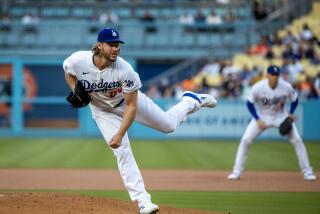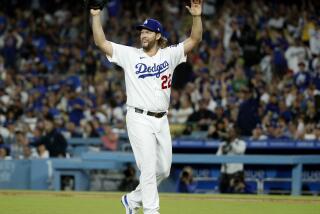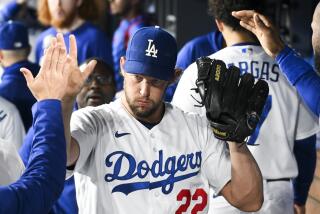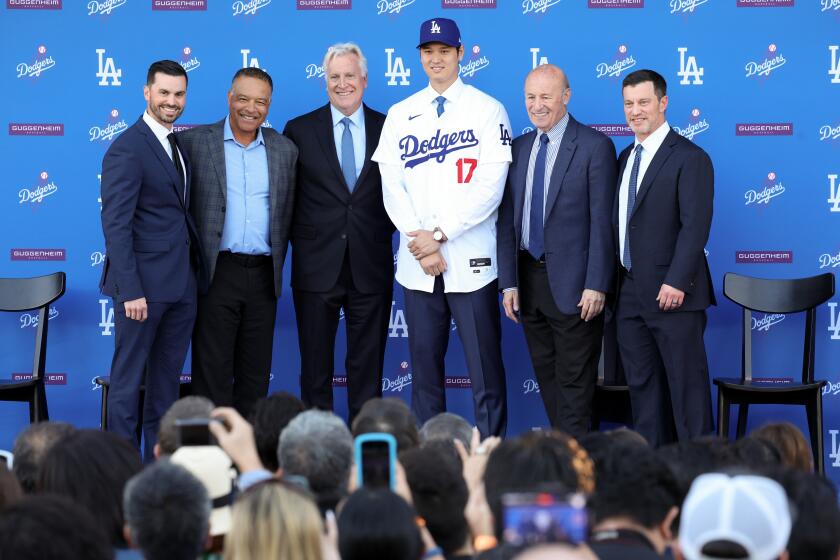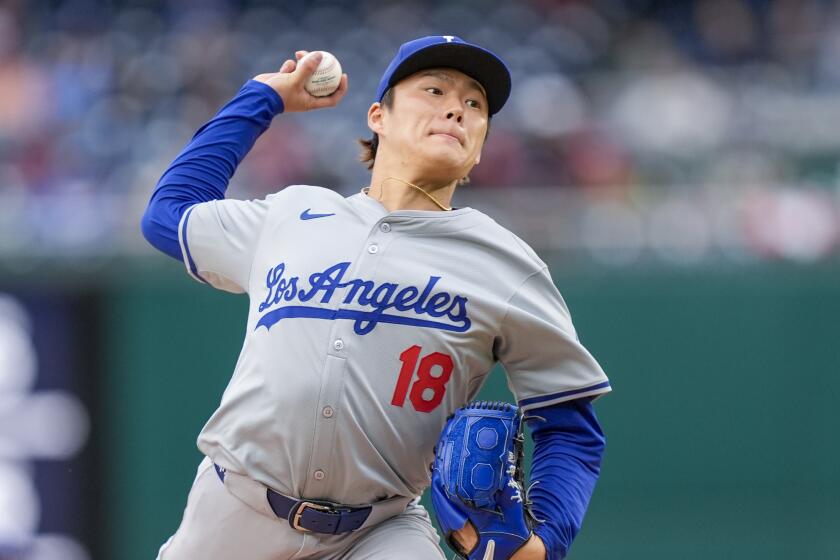As a hitter, Dodgers ace Clayton Kershaw takes an outside-the-box approach
The appreciation for Clayton Kershaw trickled through the Dodgers dugout during his outing against Colorado last week. Accolades are customary for his performances on the mound, but these he earned with a bat in his hand.
After falling into an 0-2 count against Rockies starter Tyler Anderson, Kershaw held back on a pair of cutters that missed the strike zone, then fouled away a 93-mph fastball on the outer edge to extend the at-bat.
“Man,” backup infielder Rob Segedin joked to hitting coach Turner Ward, “he’s got the best two-strike approach on the team.”
The discipline and intensity that define Kershaw as a pitcher extend to his performance inside the batter’s box. His skills as a hitter are ordinary: He finished that at-bat against Anderson by grounding out. Yet in his own way, he manages to interject himself into his team’s offense.
Kershaw entered Monday leading all major league pitchers with three runs scored in his four starts.
The most light-hearted portion of Kershaw’s day occurs a few hours before the evening’s first pitch, when he takes batting practice along with the other pitchers. He bounds out of the dugout most days at Dodger Stadium around 3 p.m. so he can take part. Obsessed with his craft and fixated on execution, Kershaw relishes the opportunity to compete in an arena with lowered expectations.
“It’s part of the job,” said Kershaw, who will take a 3-1 record and 2.54 earned-run average into a start Tuesday against the San Francisco Giants at AT&T Park. “But there’s really no pressure to it. You can enjoy yourself.”
Kershaw is not an exceptionally effective hitter. He does not possess the power of Giants starter Madison Bumgarner, who has 16 homers in eight big league seasons and flirted with appearing in the home run derby last summer, or New York Mets starter Noah Syndergaard, who took Kenta Maeda deep twice in a game last season. Kershaw hit a home run in 2013 and a triple in 2014, but he has amassed only nine extra-base hits since he debuted in 2008.
Even so, Manager Dave Roberts did not hesitate when asked where Kershaw ranked as a hitter among Dodgers pitchers. “He’s No. 1,” Roberts said. What separates Kershaw from the others is his tenacity, his refusal to give away at-bats. With his 6-foot-4 frame, Kershaw presents a sizable strike zone for opposing pitchers. He compensates with enough hand-eye coordination to drive up pitch counts, either through patience or doggedness, and enough focus to stay defiant despite his technical disadvantages.
“It just speaks to his competitiveness,” Roberts said. “That’s all it is. It’s not even mechanically driven. It’s just competing.”
Added Ward, “It’s good to see a guy get in there, knowing he can foul off and spoil some pitches.”
From 2013 to 2015, Zack Greinke served as the unquestioned leader among Dodgers pitchers at the plate. He batted .328 in 2013 and posted a .657 on-base-plus-slugging percentage during those three seasons. Kershaw resides on a more pedestrian plane.
Since 2013, 82 pitchers have had 100 plate appearances or more. Kershaw ranks 24th in batting average (.165), 16th in on-base percentage (.213) and 26th in slugging percentage (.207). The statistic that best showcases his value is strikeout percentage. He ranks 10th among those qualified with a 27% strikeout rate.
Asked to describe his strengths as a hitter, Kershaw was succinct. “I have the ability to make contact,” he said. “That’s probably it.”
This awareness plays into his preparation. Kershaw regiments his life into five-day increments. On the first two days after a start, he focuses on maintenance of his body, the cardio, stretching and lifting necessary to keep his back limber and his shoulder strong. During the next two days, he shifts his focus to his upcoming outing, as he breaks down video and analyzes the tendencies of the opposing hitters.
His study extends to the patterns of the pitchers, too. He understands his limitations. His goals are not lofty. “I don’t want to be detrimental,” Kershaw said.
“All I want to be able to do is have some type of plan,” he continued. “Like not just strike out on three pitches. I want to be able to go up there and foul some pitches off, maybe get a bunt down. Or maybe, in a big situation, get a hit. I don’t want to feel helpless.”
In this age of statistical analysis, hitters are flooded with data. There are few secrets. The only dilemma is the sport’s oldest: Hitting a round ball with a round bat.
“All these hitters will tell you: They know exactly what these guys are going to try to do to get them out,” Kershaw said. “The hard part is laying off the stuff you should, swinging at the pitches you should and not missing. I can tell you what the guy is going to throw me. It’s the hitting that’s the hard part.”
Kershaw was not always useful at the plate. In his first three seasons, he batted .076 without an extra-base hit. He became more proficient in 2011, the year he won his first National League Cy Young Award, as he improved his average to .225.
“I have no reason for that,” Kershaw said. “Maybe it was just like pitching. It took me a little while to get comfortable.”
His performance against the Rockies last week was instructive. He took six pitches against Anderson in his first at-bat. In his last time up, he fouled off a 96-mph fastball and an 84-mph curveball from reliever Jordan Lyles before striking out. In between, he laid down a sacrifice bunt to advance a runner to third base, reached first on an error by Anderson and scored two batters later.
Kershaw performed the duty he feels he owes his teams. He was not hopeless at the plate. He was helpful. His manager was appreciative.
“I enjoy his at-bats,” Roberts said. “I really do.”
Twitter: @McCulloughTimes
More to Read
Are you a true-blue fan?
Get our Dodgers Dugout newsletter for insights, news and much more.
You may occasionally receive promotional content from the Los Angeles Times.
